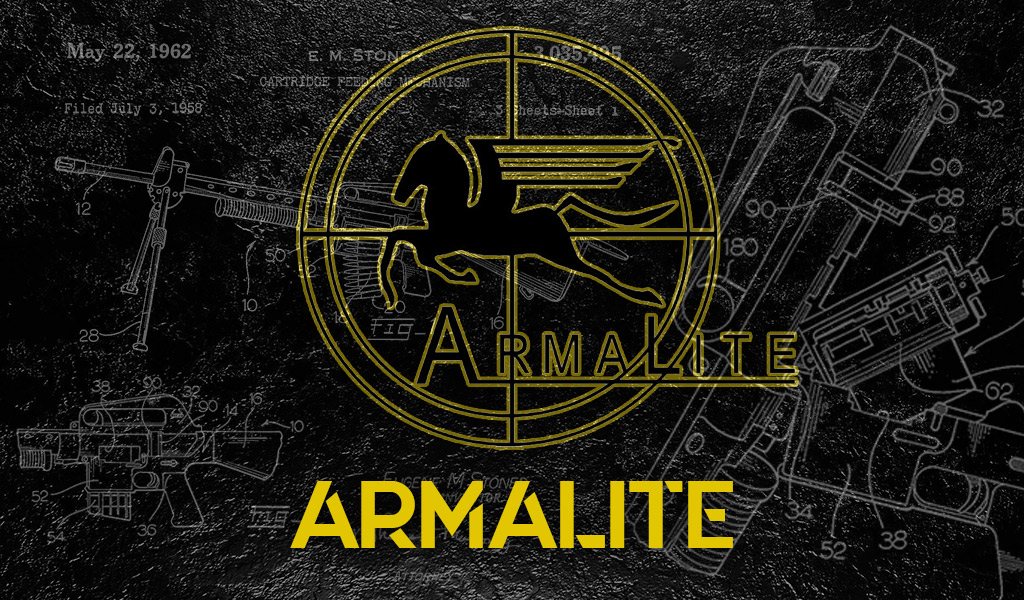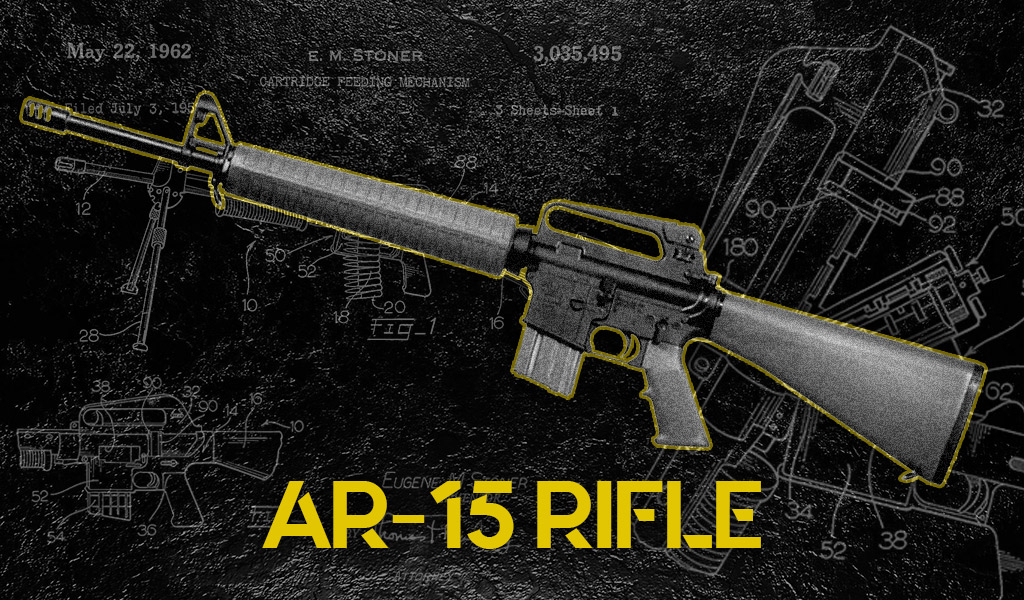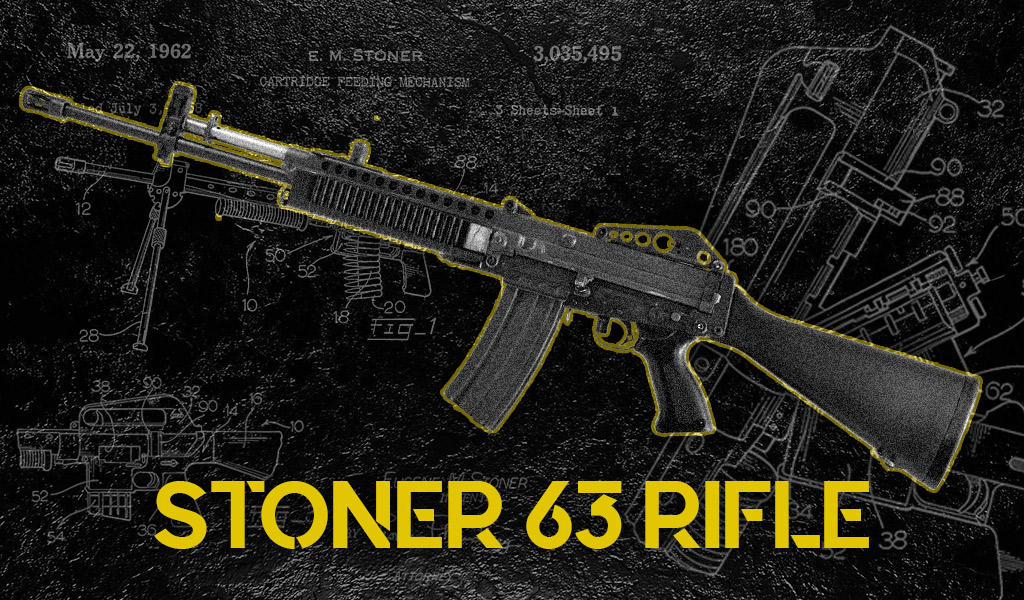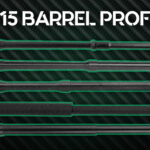
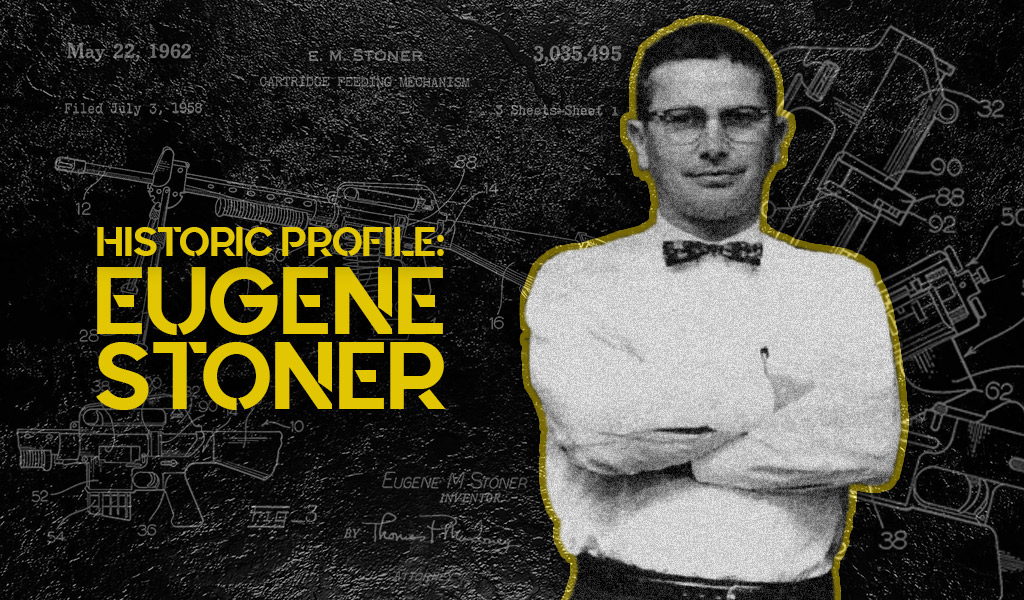
The Eugene Stoner designed Armalite Rifle AR-15 is the most popular rifle design in the US today. Popular for its modularity and performance, it has become a polarizing figure in the media on both sides of the aisle. If the mainstream media is to be believed, the ‘AR’ in AR15 stands for “assault rifle.” Rolling your eyes yet? Such futile journalistic assumptions lead to images of the rifle being developed by a faceless, nameless, government agency in a lab. Thankfully, with a little research, we know that’s not the case.
The individual talent and insight funneled into a product with over six decades of national and personal service is still astonishing. This ingenuity and design isn’t traced back to a bureaucratic committee, but to the mind of Eugene Morrison Stoner. If you’ve ever held an AR-15 rifle in your hands, he’s the man to thank for it. At the time, many saw it as a .22 caliber pop-gun trying to replace the venerable M14. However, the AR-15 became an American institution. The modularity and the economy of the caliber it uses is nothing compared to its celebrity status. Television, film and cultural lore have kept it at the forefront of military and then civilian use since 1964.
The Birth Of A Legend
Eugene Stoner was born November 22, 1922 in Gasport, Indiana, the only child of Lloyd and Britannia nee Morrison Stoner. The family ultimately moved to Long Beach, California. Between his graduation from a technical high school and US entry into World War II, at the end of 1941, Stoner worked in the Vega Aircraft Company installing armament.
Vega had just recently switched to making military and training aircraft. President Franklin Roosevelt intended to make the US into the Arsenal of Democracy before the Japanese surprise attack on Pearl Harbor. To that point, weapons manufacturing became one of the more successful, and often ignored aspects of the New Deal.
Eugene Stoner Joins The Marines
It was at Vega that Eugene learned a bit about machining armaments. It also gave him training for when war was declared he enlisted in the Marine Corps. When basic training ended he was assigned to aviation ordnance in the Pacific Theatre, ultimately serving all the way to northern China.
After the war’s end in 1945, Eugene found work for Whitaker, an aircraft equipment manufacturer. After becoming design engineer there, he moved to Fairchild Engine & Airplane Corporation in 1954, as chief engineer for a newly created, small division called Armalite headed by George Sullivan, a patent counsel for Lockheed Corp. The two actually met while Sullivan was test-firing a new prototype for an Airforce survival rifle at a local range.
ArmaLite Weapons
Armalite, headquartered outside Hollywood, California, was never meant to be a large weapons maker but instead a weapon’s innovator. Eugene Stoner’s input on the survival rifle resulted in the Armalite Rifle 5, or AR5. It was a new tool intended for the crews of the new XB70 supersonic bomber. However, the experimental nuclear bomber fleet was canceled by the government leaving the M4 and M6 survival rifles then in service sufficient to the USAF’s needs. Nevertheless, the selection of the AR5 (designated the MA-1 by the government) put Armalite on the military’s radar as a viable weapon’s designer. Today the AR5 is best known as the AR7 or the US Survival Rifle by Henry Rifle.
AR-10 Rifle Design
There were other AR rifle designs Stoner participated in, but the next big break came in 1955. The US Army issued a tender for a new battle rifle and he answered. By 1956, the caliber selected was the newly adopted 7.62 NATO and Eugene Stoner completed his new design. Incorporating alloy receivers and plastic furniture to reduce weight with a pistol grip for better control on rapid fire. The AR10 arrived late to the Aberdeen trials, however, and the US Army adopted what became the M14 which had many similarities to the venerable M1 Garand. The AR10 was later sold to Artillerie Inrichtingen, a Dutch firm that manufactured the AR-10 and sold it to various military forces, including Portugal and Sudan.
Vietnam War: M14 Controversy
While the US military ran with the M14, justifiably considered by many to be a sublime battlefield rifle, especially at medium to long-range, some detrimental features became apparent in the following years. Those included the rifle’s weight as well as the weight of sufficient rounds to be considered combat effective. There was also the observation that a full-sized rifle round was perhaps too much overkill for engagement distances that were frequently 300 yards or less.
In the coming conflict in Vietnam, combat engagement was frequently much closer. The jungle made visual contact rare over even 50 yards, making the 7.62 NATO round a bit much. Finally, there was the ability of even well-trained soldiers to control the M14 on full auto fire. The notion of giving every infantryman the equivalent of a Browning Automatic Rifle (BAR) sounded impressive on paper, but the M14 weighed considerably less and recoiled considerably more.
The Kalashnikov Connection: AK-47
These concerns were brought into sharp focus when the US learned of a new rifle the Soviets began fielding: the Automatic Kalashnikov model 47. While originally identified as a meek submachinegun, reports of its performance during the Hungarian Revolt in 1956 raised eyebrows. An intelligence inquiry revealed it to be firing an intermediate .30 caliber rifle round, the 7.62x39mm. While smaller than a standard military rifle round, the 7.62×39 is much more capable than a pistol caliber submachinegun.
Add a high capacity, detachable magazine and US MIlitary brass knew this full-auto firearm was a force to be reckoned with. This meant more rounds per pound and more manageable full-automatic fire. The M14 was and is a superior rifle for engaging targets at 600 yards, but there was little point if soldiers could not see the enemy until they got closer. Now each enemy soldier was able to lay down the reasonably accurate automatic fire with more rounds than the Americans.
223 Remington Ammo
Another official US military tender went out, actually two. In addition to a new rifle, there was also a search for a new round. Remington Arms had been exploring small-diameter bullets at hyper velocities. Looked at as wildcat varmint rounds, the capability of a fast-moving round that became unstable on contact meant frightening traumatic soft tissue damage for such a small bullet. Smaller cartridges also meant more manageable when fired automatically as well as more cartridges carried by individual soldiers, making them more combat effective. The .223 Remington was selected as the most acceptable candidate for a new rifle.
Modern Sporting Rifle: The AR-15
Meanwhile, back at the ranch, or rather at Armalite, Eugene Stoner re-evaluated and downsized his AR-10 design. With the help of two assistants; Jim Sullivan and Robert Fremont, the focus was on reducing weight and size. The objective was a light battlefield rifle, easy to use and capable of penetrating a standard helmet. It also needed to offer full controllability when fired on full auto. The AR15 was developed and prototyped by 1959. However, Armalite was never intended to be a full on producer of military firearms, only a testing house for plans that could be sold to other manufacturers. That same year the company ended deciding it had taken the designs as far as their resources would allow and sold the rifle rights to Colt.
From there the AR-15 was pitched to the US military by Colt and in 1962 it was issued to the US Air Force and Special Forces units. With US involvement in Vietnam becoming more obvious, Springfield Armory announced it could not keep up with demand. US Secretary of Defense, Robert McNamara, heard of the new, lightweight and cheaper rifle. After inspection, he ordered it as a replacement for the M14 for all combat troops serving South East Asia.
Of course, the new rifle had a new cartridge and the order went out for that too. Remington was not capable of producing sufficient quantities alone. Winchester’s Olin Corporation was contracted to make up the shortfall. In the rush, the decision was made to substitute the original ball powder for Dupont stick powder. On paper, it offered no change in ballistic energy, it simply burned a little less fully resulting in just a bit more fouling.
Gas Impingement System
Eugene Stoner’s design did not use a piston-like the M1 or M14. Instead, it used gas impingement: tapping expanding propellant gasses out of the barrel back to cycle the action. This inevitably blew carbon into the chamber, but with the stick powder substitute, the amount of material was substantially more than the tight tolerances of the AR15’s design. No one seemed to consider this while answering the need to get the rifles into the field. In fact, because the force with which the high-velocity rounds left the muzzle, the AR15/M16 rifle system was initially advertised as self-cleaning. Suffice it to say, when extra dirty propellant is used in a damp environment, the rifle is NOT self-cleaning.
Failures & Controversy
How many GI’s died while attempting to get their weapon to function is unknown. What is known is that the rifle experienced a quick redesign to incorporate a forward assist while training materials and cleaning kits were rushed to the combat units and ball powder was put back into the mix at Olin.
While indirectly reflecting back on Eugene Stoner, the teething problems of the rifle were out of his hands. In fact, they would have been avoided had the principles of the original design been kept to. As to Armalite, it had not yet turned enough profit from its efforts and in 1962, Fairchild opted to sever its association with the company.
ArmaLite AR Variants
On its own, Armalite began working on a new rifle design. One that operated off of a traditional piston system and used stamped and welded construction rather than the aluminum forged receiver pieces of the AR15/M16 platform. The AR16 was chambered in 7.62 NATO but never made it to production. At the same time, work on a self-loading shotgun was done, producing around 1200 units of what would be known as the AR17.
In 1963, headed by designer Art Miller, the AR16 was re-evaluated. The intention was to make a less expensive alternative to the AR15: the select fire AR18 and a semi-automatic version, the AR180. The 18 underwent trials but failed to prove itself any better than the AR15/M16 already selected for service.
Armalite Evolution
While some adjustments were made as a result of the US military trials, the rifle failed to garner any real market success. The AR18 was produced by Howa in Japan for exceedingly limited domestic use. Sterling Arms in Great Britain took advantage of the rifle’s greatest contributions: a stepping stone in Britain’s own SA80 rifle: essentially an AR18 bullpup. They were confident in the design. After all a number of AR180s found themselves illegally shipped to the Irish Provisional Army at some point in the 1970s.
The AR180 also proved an evolutionary step towards the AR100 series. The series became the 101 (rifle), 102 (carbine), 103 (rifle with auto ejecting drum magazine) and 104 (squad automatic weapon with auto ejecting drum mag). Yet none of these designs made their way into widespread production either.
By 1970, the company had effectively stopped designing and building rifles. Parts and tools, along with the name were sold off with the brand name. They were purchased in 1996 by Mark Wastrom who started building AR rifles as well as a .50 BMG capable rifle. In 2013 Armalite became part of the Strategic Armory Corporation.
Eugene Stoner: Life After ArmaLite
What happened to Eugene Stoner? He left Armalite the year before Fairchild cut ties back in 1961 to become a consultant for Colt. However, Colt is not known for being a proving ground of weapons development, preferring to make and sell purchased designs. Not content to twiddle his thumbs or correct mistakes made by others, Stoner moved on. He knew the issues around feeding his rifle designs the wrong powder, but he didn’t let it slow him down. Stoner approached Cadillac Gage (now the armored vehicle maker Textron) with his idea of a new modular weapon system.
A new system that utilized the same AR-style receiver, but could fulfill the role of battle rifle, carbine or squad support. Similar to what the AR100 series would become over at Armalite (one wonders where they got the idea), but instead of chambered in 5.56mm. The Stoner M69W (the designation has no explanation other than being able to be read upside down or right side up and saying the same) rifle system was chambered in 7.62 NATO. It was eventually put into production in 1962 as the Stoner 62. The following year a 5.56 NATO variant (it was inevitable) was put into trial production as the Stoner 63.
Despite some lackluster results in tests – both rifle systems have fairly strict pressure requirements. The accurate pressure is needed to cycle reliably and varying types of service ammo did not guarantee consistently reliable performance. However, both systems were utilized by special forces through to 1983.
Eugene Stoner then worked on a 25mm autocannon for TRW aerospace. The design was picked up by Oerlikon, a division of Rheinmetall, the German armaments manufacturer.
ARES Incorporated
ARES Incorporated was founded in Ohio in 1972 with Eugene as a co-founder. While there he made some improvements on his Stoner 63. It was presented at the ARES LMG, as aka the Stoner 86. There were also developments on the Future Assault Rifle Concept. FARC was an experimental think tank. It focused not only on new weapons systems but also new forms of ammunition, including polymer and telescoping cartridges.
Civilian Market Success
During this time, the US firmly extricated from Vietnam, the US military experienced a brief spell of being idle. There was less need for M16 rifles as the military demobilized, dissolving the draft in 1973. When the Colt patent on the rifle expired in 1977, there was little demand for the design beyond ROTC and Civilian Marksmanship Programs. At the time, the sport shooting community had little desire for a military-style rifle.
The Modern Sporting Rifle & Politics
All that began to change in the 1980s and 1990s. Modern sporting rifles were becoming more popular in the mainstream. Political talk about a ‘Federal Ban’ had them flying off of the shelves. The 1994 Federal “Assault Rifle Ban” merely forced manufacturers to make alternate designs because the ban itself increased demand. The politically motivated endeavor to ban so-called “assault rifles” nationwide, stemmed not from concern for public safety, but from politicians seeking to make a name for themselves. The lunacy peaked in 1995 when (term-limits poster child), Sen. Dianne Feinstein (D-CA) appeared on 60-Minutes announcing her tyrannical desires for unconstitutional gun confiscation. Her ‘Maoist’ inspired words, “Mr. and Mrs. America, Turn Them All In!” sparked the start of the modern, pro-2A gun culture movement.
The threat of a new ban in 2013 created an explosion in demand even gun rights activists and manufacturers could not anticipate. The AR15 became the rallying point of gun rights by being the target of tired arguments by gun control activists. There is strong evidence to suggest leftist political motivations were behind the calls to ban the rifle. This coming after several high profile shootings from the DC Sniper to Sandy Hook, to Las Vegas where the rifle was used. This made the AR15 system a celebrity, reviled on one side and adored on the other. With Colt no longer in possession of the patent, virtually every major firearms maker (and hundreds of start-up companies) dedicated their time to manufacture parts and accessories.
Knight’s Armament
For Stoner himself, he left ARES in 1990 and joined the Knight’s Armament Company. There he returned to his AR-10 with almost three decades of field notes on the AR15 to incorporate. He shortly after developed the SR25: a 7.62NATO chambered semi-automatic precision rifle. It was adopted by Special Operations Command and the US Navy as the Mark 11 Sniper weapon System. This was perhaps the last of Stoner’s successful models, though it was slated for replacement by the SSR Mk20, an FN SCAR variant, by 2017.
When Stoner Met Kalashnikov
The two famously met in Washington DC in May of 1990. They visited the NRA and Smithsonian Museums and even went shooting at a local hunting lodge. It is reported that they shared a bond with each other. It is a gun geek’s daydream to ponder what these two men might have said to each other. Did they discuss how society perceived them, how governments profited off of them, or possibly world peace?
Their respective designs represented both superpowers of the Cold War, and post Cold War world. Neither man had any formal technical engineering education, but seemed to learn as they went. Picking up trade skills in the military in World War II and after. Yet one commonality the two men may have also shared was that their creations took on lives of their own. Each of their famous designs were mass-produced and copied with and without licenses all over the world.
Eugene Stoner’s Final Projects
The last two projects that most notably bore his involvement were the Colt 2000 and the KAC SR50. The former being a collaboration for a new semi-automatic pistol for Colt. Once the original designs were submitted, however, Colt made adjustments without consulting the designers. The changes were largely interpreted as the opposite of improvements. The pistol was further plagued by bad press and a reputation for functionality and accuracy issues.
The SR50 was a response to the Navy’s request for a .50 BMG, self-loading sniper rifle. Unfortunately, the 1990s encouraged the first of a series of gun ban scares. The reality of a ban had manufacturers scrambling to get models out before new laws went into effect. The focus then became making alternative models that were specifically not banned by the 1994 Federal law, instead of focusing on new innovations. The SR50 fell by the wayside before ultimately being abandoned (only four were built) in favor of available models such as the Barrett M82.
Name-Brand Recognition?
By this point, Eugene Stoner’s health had begun to deteriorate. It is possible, given the growing number of companies who began making AR rifles, that Stoner could have cashed in. As a response to the political divide, he could have made a fortune. He was by far the most recognized name associated with the AR pattern rifle. With all the new name manufacturers of the rifle and accessories and parts, it is difficult to believe that a new Stoner Rifle division of KAC (or some other established brand) would not have done well as a result of the current political environment.
Many have pondered why there is no Stoner branded AR rifle. It could be that Eugene enjoyed creating more than marketing, or perhaps putting his name on things just wasn’t his style. In any case, his involvement in any such future enterprise was thwarted. On April 24, 1997 he passed away while fiddling on a project in the garage of his Florida home, succumbing to brain cancer. They say old inventors never really die, they just stop filing for patents. Today Eugene Stoner’s name is firmly associated with the AR15/M16 platform. It’s rightfully listed in the history books next to the iconic schematic for the AR patent.
The Legacy Of Eugene Stoner
Eugene Stoner was a consummate tinkerer. Once an idea was deemed good enough for submission he sent it on its way to succeed or fail on its merits. He kept a set schedule so he could focus on creating something new. If possible, he returned to an idea to improve it based on new data: as was the case with the Stoner 63/86 and the AR10/25. Eugene Stoner had the Kaizen mindset, he was an inventor hell-bent on continuous improvement.
He may not have received the hundreds of millions of dollars in royalties one would expect for a lead designer, but he was successful. With a net worth classifying him as a millionaire after selling off his interest in ARES, many still sought afterwards as a consultant. He certainly did better than Kalashnikov, who died 16 years later, in a tiny Moscow apartment as a pensioner of the state. If such are the metrics of success, then Stoner indeed succeeded.
From another point of view, however, he was equally if not more successful in life. He left behind a wife, four children, seven grandchildren and several great-grandchildren. His innovative work ethic and easily integrated designs have successfully been adopted by all who followed behind him. Keeping an almost seventy-year-old firearm design not only in service but as the rallying symbol of American gun rights, is no small accomplishment. The more tyrants threaten to take gun rights away, the stronger they will be held on to. Gun owners, patriots, and inventors cannot thank him enough.


